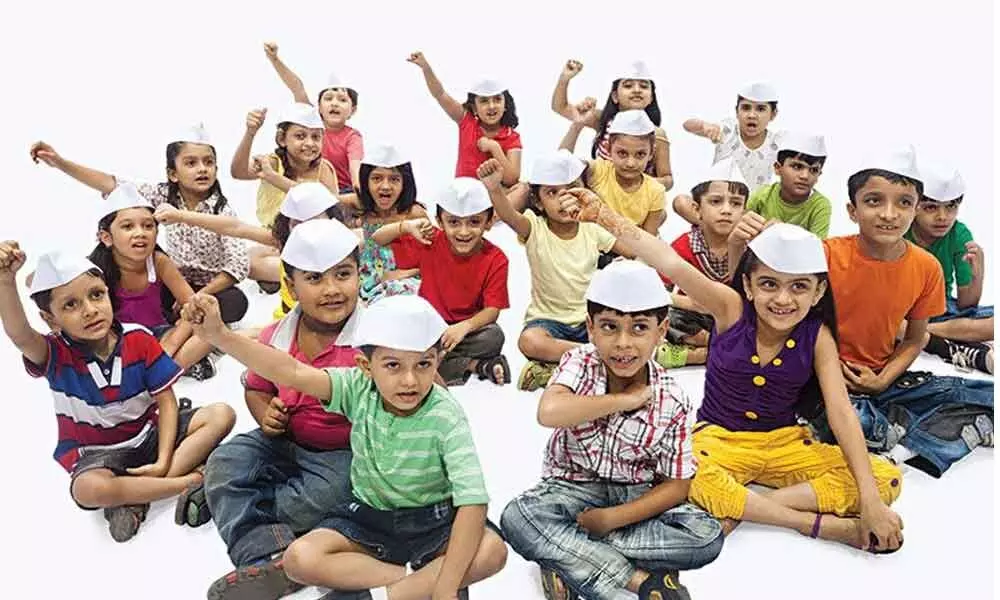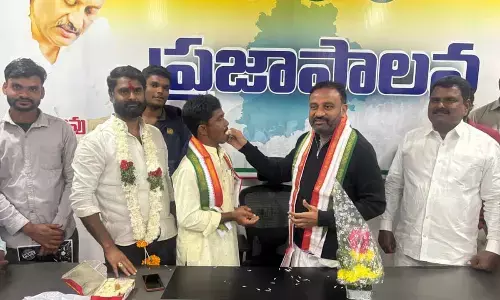Why parents should encourage children to read Constitution

Representational Image
January 26 is celebrated as the Republic Day in India. But, what is a Republic? And, what does it mean? What happened on January 26, 1950? These questions do not arise in our minds because we are conditioned to watch the pageantry on the Rajpath in Delhi where the military might, industrial progress, advances in science and technology, success in agriculture and the richness of our cultural diversity are highlighted even while emphasising the spirit of unity.
January 26 is celebrated as the Republic Day in India. But, what is a Republic? And, what does it mean? What happened on January 26, 1950? These questions do not arise in our minds because we are conditioned to watch the pageantry on the Rajpath in Delhi where the military might, industrial progress, advances in science and technology, success in agriculture and the richness of our cultural diversity are highlighted even while emphasising the spirit of unity.
But, is Republic Day all about the show of pageantry on the Rajpath in Delhi? No, it is not. A country which has an elected Head of the State is known as a Republic; example, the USA. A country whose Head of the State comes by succession through heredity is known as a monarchy; example, the UK. A country which has the Head of another country as its Head of State is known as a dominion, example, Australia, New Zealand, Canada, etc, who have accepted the British Monarch as their Head of State. The Monarch is represented by a Governor General, a ceremonial position, in those countries.
The Balfour Declaration of 1926 recognised the Dominions as "autonomous communities within the British Empire", and the 1931 Statute of Westminster confirmed their full legislative independence. India was also a dominion for a short period of time from 1947 to 1950 when we had the first Indian as the Governor General of Independent India. He was C Rajagopalachari. On the January 26, 1950, the Constitution of India came into effect and with it, all the institutions created by it followed suit.
Article 52 of the Constitution of India says that there shall be a President of India. As a result, India had its first President, Dr Rajendra Prasad elected to that office by the Constituent Assembly, and thus the Republic of India was born. The Constituent Assembly acted as a provisional Parliament till a new Parliament was constituted following the first general elections conducted on the principle of adult universal franchise.
Rajendra Prasad first took oath as the President and then participated in the Republic Day Parade as the Head of State. The short-lived dominion status thus came to an end when Rajaji ceased to be the Governor General of India, following the swearing in of the President for India.
For the first time in the 5,000 year long history of India, we got a Head of State elected democratically by the people's representatives as distinct from succession through heredity or palace intrigues that marked the succession process during the regimes of rajas and ranis. The tradition of palace intrigues ended in 1950. Thus, 26 January clearly signifies the coming into force the Constitution of India as the supreme law of the land.
While we celebrate the November 26as the Constitution Day because the Constitution was, enacted, adopted and given to ourselves by the Constituent Assembly on November 26, 1949, the Constitution came into force only on January 26, 1950. But, in our obsession with pomp and pageantry associated with the Republic Day, we seem to have forgotten the Constitution itself because no mention is made about it on 26 January either by the judiciary, the Executive or the media or the academia.
The significance of the Constitution coming into force on January 26 should not be ignored at all. But, unfortunately that seems to be the trend as we hardly find any mention of the Constitution in the euphoria of celebrating the Republic Day. What is the message we give to the future generations? Republic Day is an occasion to reminisce the misgivings expressed by the makers of the Constitution in the Constituent Assembly and to measure how far we have resolved those misgivings which were genuine at that time. On the November 25, 1949, the penultimate day of the Constituent Assembly, Ambedkar cautioned: 'On the 26th of January 1950, we are going to enter into a life of contradictions. In politics we will have equality and in social and economic life we will have inequality. In politics we will be recognising the principle of one man one vote and one vote one value. In our social and economic life, we shall, by reason of our social and economic structure, continue to deny the principle of one man one value. How long shall we continue to live this life of contradictions? How long shall we continue to deny equality in our social and economic life? If we continue to deny it for long, we will do so only by putting our political democracy in peril. We must remove this contradiction at the earliest possible moment…'
It is a warning as relevant today as it was on November 25, 1949, which was some 73 years back. What is our position today? Nobody is raising this issue any longer. The address of the President to the nation on the eve of the Republic Day or the speech of the Prime Minister from the ramparts of the Red Fort on the Independence Day hardly admit the growing distance we have to travel in order to realise the lofty goals of the Constitution. If the political leadership is afraid of admitting failure, what are the other primary institutions of the polity such as the media, academia, the judiciary, the civil society organisations doing in this respect? They are also silent about the growing tendency of undemocratic and unconstitutional methods of governance! Such tendencies should keep every conscientious individual awake from his midnight sleep. In our enthusiasm for celebration, we must not forget the fundamental problems that are afflicting our constitutional institutions, the naming of which is not necessary because everyone knows the rot has set in. The lawlessness that marks our electoral processes, the pandemonium in Parliament, the immense caseload that is pending in our courts, the weakening of the civil services, steel frame of our bureaucracy are the issues that should dampen the celebratory spirit of the Republic Day Parade.
So, what we must do to set right the situation? First of all, we must realise that we should not be satisfied with symbolism, but pay attention to the substantive issues confronting the nation. They say catch them young! We must incorporate the Constitution of India in the curriculum right from the high school stage for every student, engineering and medicine included, in order to develop respect for the Constitution, imbibe the ideals enshrined in the Constitution such as secularism, socialism, federalism, and democracy and internalise the principal features of the Constitution such as the fundamental rights and the Directive Principles. Younger generations must be made to understand that we have been given a set of justiceable rights for the first time in the history of India.
In the monarchical tradition in which we lived long, the law maker, executive and the adjudicator were all rolled into one entity called the king or queen. The fate of the people depended on the benign nature of the ruler. No more and never again! Our Constitution has put an end to such arbitrariness in governance.
In the Republican India, governance must be carried on in accordance with the Constitution and the laws made within the contours of the Constitution. That being so, is it not necessary for the younger generations to understand what Constitution is all about? And, are we doing anything to inculcate understanding of the Constitution in the young and impressionable minds? The answer is sadly NO.
At least, educated parents must keep a copy of the Constitution at home and encourage their children to read the provisions therein and familiarise themselves with what the Constitution seeks to achieve for India. But, unfortunately, we are only following the agitational methods of the freedom struggle such as bandh, hartal, strikes, hunger strikes, and deviating from the aspirations that fired the imagination of the freedom fighters. Disturbance and destruction should not be viewed as the legacy of our freedom struggle because those methods were used sometimes against alien rule. Our freedom fighters visualised a vibrant nation, a brave new nation which would achieve all round progress touching the lives of people for the better following independence. Are we anywhere closer to such a situation? Nothing is farther from truth. We must not ignore this reality. If we do so, it would be at our own peril. The media, academia, civil society organisations and informed sections of society must lay their role in order to drive home this truth.
(Author is Asst. Professor, BR Ambedkar Law College, Hyderabad)


















